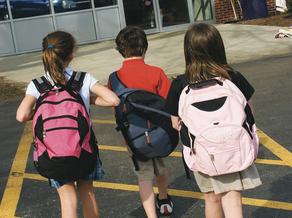It’s that time of year again – the annual search for school supplies. If a new backpack is on your list, Los Alamitos Medical Center offers some ideas to find the right backpack for your child and ensure that the backpack is being used correctly.
Backpacks can be a great way for children and teenagers to take books and supplies to and from school. When used properly, backpacks are better than purses, messenger or shoulder bags because the weight in the backpack is supported by the back and stomach muscles, which are the strongest muscles in the body.
What to look for in a backpack
First of all, remember that you should carry no more than 10 to 15 percent of your body weight in the backpack. That means an 80-pound child should have no more than 8 to 12 pounds of books and supplies in the pack.
A bag with too much weight may force the child backward and to compensate, the child will lean forward at the hips or arch the back. This posture may compress the spine and may cause shoulder, back or neck pain.
A good backpack will have two wide, padded straps and a waist strap. Although your child may want to sling the pack over one shoulder (which may be considered “cool”), you should have the child place both straps across the shoulders and wear the waist strap. This will help distribute the weight in the backpack more evenly.
Other buying tips:
- Consider the size of the backpack to the size of the child. Younger, smaller children need smaller backpacks.
- Look for a lightweight pack with lots of compartments to help distribute the weight of books and supplies.
- Find a backpack with a padded back to increase comfort and keep sharp objects from poking through the fabric.
- Wheeled backpacks may help with heavy loads but some schools don’t allow them. Also, the wheels make it hard to get the backpack up stairs and the design may not fit in a locker.
Backpack Safety Tips
So, you’ve looked at all the options and have selected the right backpack for your child. Let’s talk about some backpack safety measures you and your child can take.
Make sure your child knows how to wear a backpack. He or she should use both shoulder straps. Check to be sure the straps are tight enough so that the backpack rests close to the body. Look at how the backpack rests on the back. It should be even in the middle of the back and not fall below the curve of your child’s lower back.
As with any weight, proper lifting is essential to protecting the back. Teach your child to bend at the knees, grab the pack with both hands and then lift it to the shoulder.
Backpacks can be a hazard to others. Encourage your child to look around before taking the backpack off and try to place it away from walkways so no one trips.
Continue to look for signs that your child is carrying too much in a backpack, such as:
- Struggling to get the backpack on or off
- Leaning forward or hunching over while carrying the backpack
- Talking about back pain or numbness or weakness in the arms and legs
How to Lighten the Load
When your child first brings home the loaded backpack, you may be astonished at the number of materials and heavy books your child is carrying. Try to limit unnecessary items in the backpack such as laptops, cell phones and video games. Talk to your child’s school and see if paperback or CD-ROM versions of books are available. Some schools have started placing curriculum materials on the school’s website.
Talk to your child about using a locker during the day for books and supplies instead of carrying everything throughout the day. Also, only materials needed for homework or studying should be brought home at night.
If you notice that your child is bringing more stuff home on Friday, check to see if he or she is putting off homework during the week. Good planning may save your child’s back.
If your child continues to complain about physical symptoms of back or neck pain, you should consult a doctor.

